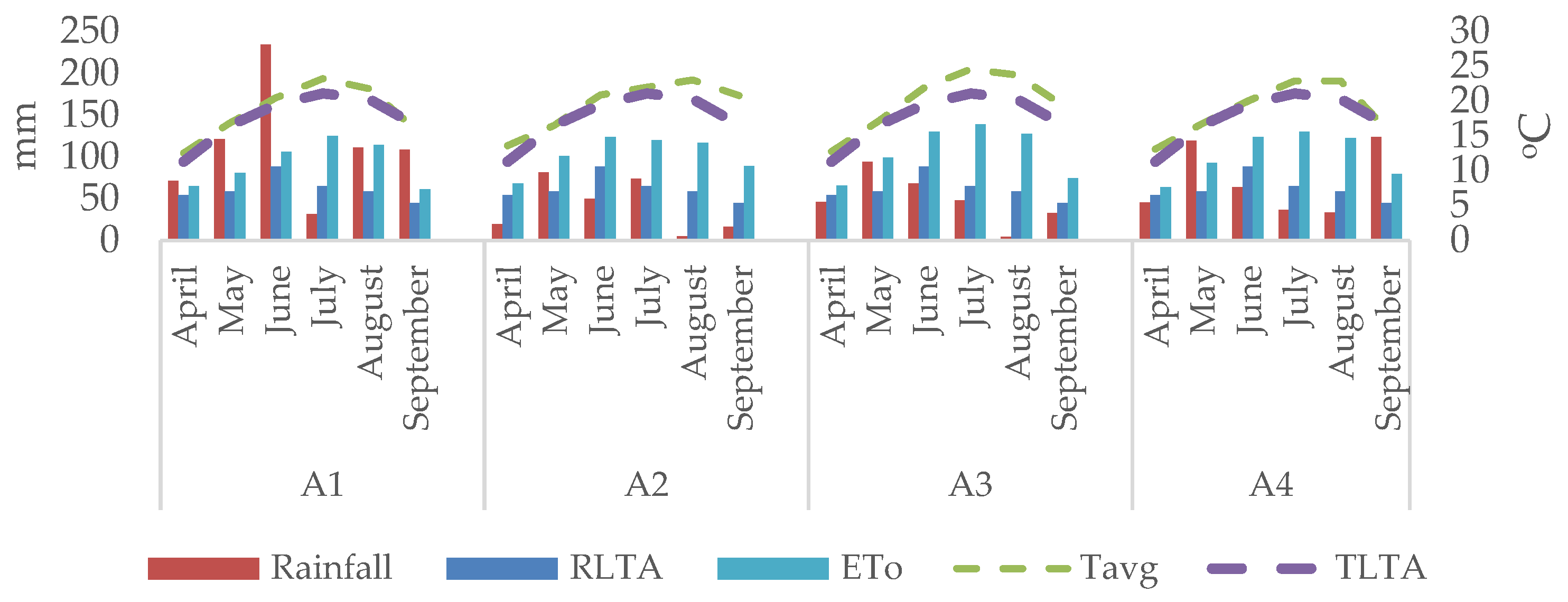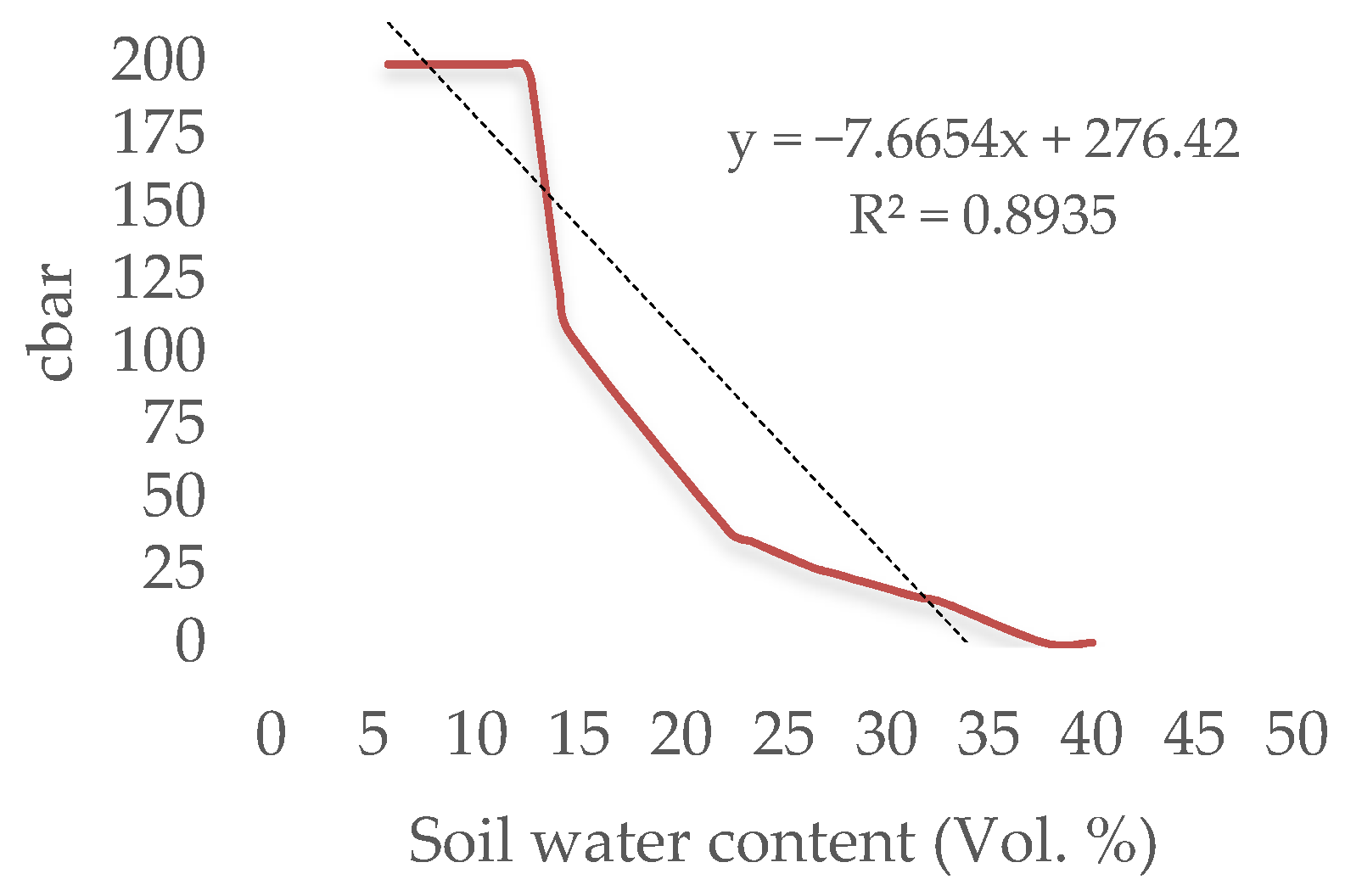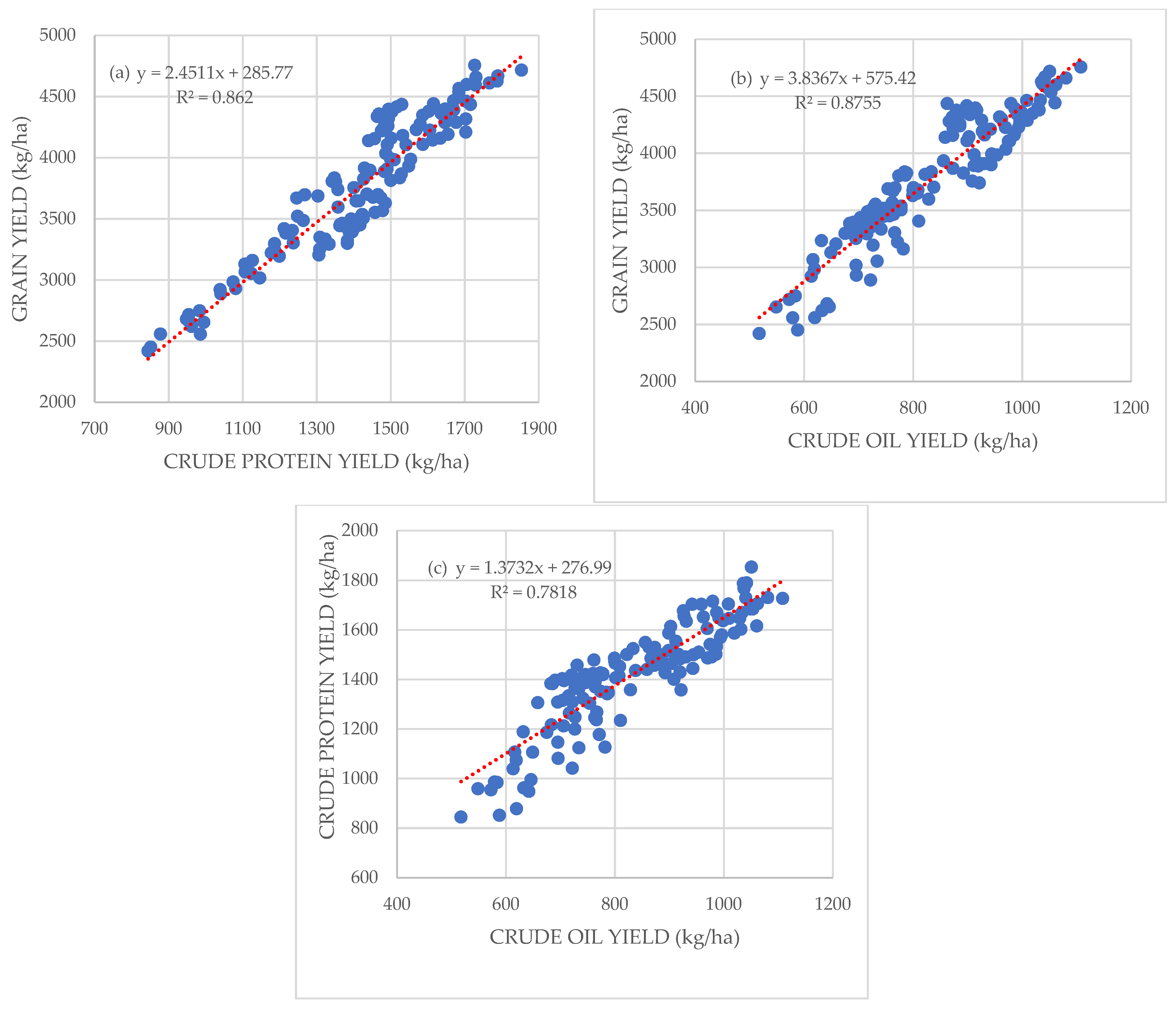Environment- and Genotype-Dependent Irrigation Effect on Soybean Grain Yield and Grain Quality
Abstract
1. Introduction
2. Materials and Methods
3. Results
3.1. Meteorological Conditions and Crop Water Requirements
3.2. Grain Yield
3.3. Grain Protein Content and Crude Protein Yield
3.4. Grain Oil Content and Crude Oil Yield
3.5. Correlation and Regression Analyses
4. Discussion
5. Conclusions
Author Contributions
Funding
Institutional Review Board Statement
Informed Consent Statement
Data Availability Statement
Conflicts of Interest
References
- Cober, E.R.; Cianzio, S.R.; Pantalone, V.R.; Rajcan, I.S. Oil Crops. In Handbook of Plant Breeding; Vollmann, J., Rajcan, I., Eds.; Springer: New York, NY, USA, 2009; Volume 4, pp. 57–90. [Google Scholar]
- Food and Agricultural Organization of United Nations (FAO). Crops and Livestock Products. 2022. Available online: https://www.fao.org/faostat/en/#data/QCL (accessed on 18 June 2022).
- Kim, S.W.; Less, J.F.; Wang, L.; Yan, T.; Kiron, V.; Kaushik, S.J.; Lei, X.G. Meeting global feed protein demand: Challenge, opportunity, and strategy. Annu. Rev. Anim. Biosci. 2019, 7, 221–243. [Google Scholar] [CrossRef] [PubMed]
- Rossi, R.; Irrigation in EU Agriculture. European Parliamentary Research Service. 2019. Available online: https://www.europarl.europa.eu/regdata/etudes/BRIE/2019/644216/EPRS_BRI(2019)644216_EN.pdf (accessed on 9 June 2022).
- Saleem, A.; Aper, J.; Muylle, H.; Borra-Serrano, I.; Quataert, P.; Lootens, P.; De Swaef, T.; Roldán-Ruiz, I. Response of a diverse European soybean collection to “short duration” and “long duration” drought stress. Front. Plant Sci. 2022, 13, 818766. [Google Scholar] [CrossRef] [PubMed]
- Rosa, L.; Chiarelly, D.D.; Rulli, M.C.; Angelo, J.; Odorico, P. Global agricultural economic water scarcity. Sci. Adv. 2020, 6, eaaz6031. [Google Scholar] [CrossRef] [PubMed]
- IPCC. Climate Change 2014: Synthesis Report. Contribution of Working Groups I, II and III to the Fifth Assessment Report of the Intergovernmental Panel on Climate Change; Pachauri, R.K., Meyer, L.A., Eds.; IPCC: Geneva, Switzerland, 2014; p. 151. Available online: https://www.ipcc.ch/report/ar5/syr/ (accessed on 4 July 2022).
- Maleki, A.; Naderi, A.; Naseri, R.; Fathi, A.; Bahamin, S.; Maleki, R. Physiological Performance of Soybean Cultivars under Drought Stress. Bull. Environ. Pharmacol. Life Sci. 2017, 2, 38–44. [Google Scholar]
- Fehr, W.R.; Caviness, C.E. Stages of Soybean Development; Special Report No. 87; Iowa State University: Ames, IA, USA, 1977; Available online: https://lib.dr.iastate.edu/specialreports/87 (accessed on 27 September 2022).
- Board, J.E.; Kahlon, C.S. Soybean yield formation: What controls it and how it can be improved. In Soybean Physiology and Biochemistry; El-Shemy, H.A., Ed.; Intech: London, UK, 2011; pp. 1–36. [Google Scholar]
- Bošnjak, Đ. Soybean irrigation in single crop, second crop and stubble crop planting. In Soybean; Miladinović, J., Hrustić, M., Vidić, M., Eds.; Institute of Field and Vegetable Crops Novi Sad: Sojaprotein Bečej, Serbia, 2011; pp. 315–342. [Google Scholar]
- He, J.; Jin, Y.; Du, Y.-L.; Wang, T.; Turner, N.C.; Yang, R.P.; Yi, J.; Xi, Y.; Zhanga, C.; Cui, T.; et al. Conserved water use improves the yield performance of soybean (Glycine max (L.) Merr.) under drought. Agric. Water Manag. 2016, 179, 236–245. [Google Scholar] [CrossRef]
- Candoğan, B.N.; Yazgan, S. Yield and quality response of soybean to full and deficit irrigation at different growth stages under sub-humid climatic conditions. Tarim Bilimleri Dergisi J. Agric. Sci. 2016, 22, 129–144. [Google Scholar] [CrossRef]
- Kresović, B.; Gajić, B.A.; Tapanarova, A.; Dugalić, G. Yield and chemical composition of soybean seed under different irrigation regimes in the Vojvodina region. Plant Soil Environ. 2017, 63, 34–39. [Google Scholar]
- Galić Subašić, D.; Jurišić, M.; Jug, I.; Josipović, M.; Kiš, D.; Rapčan, I. The effect of irrigation and nitrogen fertilization on the soybean seed yield, with a correlation to the protein and oil concentration. Poljoprivreda 2020, 26, 50–57. [Google Scholar] [CrossRef]
- He, J.; Jin, Y.; Turner, N.C.; Li, F.M. Irrigation during flowering improves subsoil water uptake and grain yield in rainfed soybean. Agronomy 2020, 10, 120. [Google Scholar] [CrossRef]
- Pinnamaneni, S.R.; Anapalli, S.S.; Fisher, D.K.; Reddy, K.N. Water use efficiencies of different maturity group soybean cultivars in the humid Mississippi Delta. Water 2021, 13, 1496. [Google Scholar] [CrossRef]
- Marković, M.; Josipović, M.; Ravlić, M.; Josipović, A.; Zebec, V. Deficit irrigation of soybean (Glycine max (L.) Merr.) Based on monitoring of soil moisture, in sub-humid area of eastern Croatia. Rom. Agric. Res. 2016, 33, 1–8. [Google Scholar]
- Anda, A.; Soós, G.; Menyhárt, L.; Kucserka, T.; Simon, B. Yield features of two soybean varieties under different water supplies and field conditions. Field Crops Res. 2020, 245, 107673. [Google Scholar] [CrossRef]
- Aydinsakir, K. Yield and quality characteristics of drip-ırrigated soybean under different irrigation levels. Agron. J. 2018, 110, 1473–1481. [Google Scholar] [CrossRef]
- Aydinsakir, K.; Dinc, N.; Buyuktas, D.; Kocaturk, M.; Ozkan, C.F.; Karaca, C. Water productivity of soybeans under regulated surface and subsurface drip irrigation conditions. Irrig. Sci. 2021, 39, 773–787. [Google Scholar] [CrossRef]
- Morsy, A.R.; Mohamed, A.M.; Abo-Marzoka, E.A.; Megahed, M.A.H. Effect of water deficit on growth, yield and quality of soybean seed. J. Plant Prod. 2018, 9, 709–716. [Google Scholar] [CrossRef]
- Zaninović, K.; Gajić Čapka, M.; Tadić, M.P.; Vučetić, M.; Milković, J.; Bajić, A.; Cindrić, K.; Cvitan, L.; Katušin, Z.; Kaučić, D. Climate Atlas of Croatia; Meteorological and Hydrological Service of Croatia: Zagreb, Croatia, 2008. [Google Scholar]
- FAO. World Reference Base for Soil Resources 2014, International Soil Classification System for Naming Soils and Creating Legends for Soil Maps. 2015. Available online: http://www.fao.org/3/i3794en/I3794en.pdf (accessed on 15 May 2020).
- Allen, R.G.; Pereira, L.S.; Raes, D.; Smith, M. Crop Evapotranspiration Guidelines for Computing Crop Water Requirements; FAO Irrigation and Drainage Paper 56; FAO: Rome, Italy, 1988; Available online: https://www.fao.org/3/X0490E/x0490e00.htm (accessed on 5 May 2022).
- Brouwer, C.; Prins, K.; Heibloem, M. Irrigation Water Management: Irrigation Scheduling. FAO Land and Water Development Division; FAO: Rome, Italy, 1989. [Google Scholar]
- Basal, O.; Szabó, A. Physiology, yield and quality of soybean as affected by drought stress. Asian J. Agric. Biol. 2020, 8, 247–252. [Google Scholar] [CrossRef]
- Pinnamaneni, S.R.; Anapalli, S.S.; Reddy, K.N.; Fisher, D.K.; Quintana-Ashwell, N.E. Assessing irrigation water use efficiency and economy of twin-row soybean in the Mississippi Delta. Agron. J. 2020, 112, 4219–4231. [Google Scholar] [CrossRef]
- Cui, Y.; Jiang, S.; Jin, J.; Feng, P.; Ning, S. Decision-making of irrigation scheme for soybeans in the Huaibei Plain based on grey entropy weight and grey relation-projection pursuit. Entropy 2019, 21, 877. [Google Scholar] [CrossRef]
- Board, J.E. A regression model to predict soybean cultivar yield performance at late planting dates. Agron. J. 2002, 94, 483–492. [Google Scholar] [CrossRef]
- Ali, O.A.M.; Abdel-Aal, M.S.M. Importance of some soil amendments on improving growth, productivity and quality of soybean grown under different irrigation intervals. Egypt. J. Agron. 2021, 43, 13–27. [Google Scholar] [CrossRef]
- Foroud, N.; Muèndel, H.H.; Saindon, G.; Entz, T. Effect of level and timing of moisture stress on soybean yield, protein, and oil responses. Field Crops Res. 1993, 31, 195–209. [Google Scholar] [CrossRef]
- Bouniols, A.; Texier, V.; Mondies, M.; Piva, G. Soybean seed quality among genotypes and crop management: Field experiment and simulation. Eurosoya 1997, 11, 87–99. [Google Scholar]
- Pannecoucque, J.; Goormachtigh, S.; Heungens, K.; Vleugels, T.; Ceusters, J.; Van Waes, C.; Van Waes, J. Screening for soybean varieties suited to Belgian growing conditions based on maturity, yield components and resistance to Sclerotinia sclerotiorum and Rhizoctonia solani anastomosis group 2–2IIIB. J. Agric. Sci. 2018, 156, 342–349. [Google Scholar] [CrossRef]
- Clemente, T.E.; Cahoon, E.B. Soybean oil: Genetic approaches for modification of functionality and total content. Plant Physiol. 2009, 151, 1030–1040. [Google Scholar] [CrossRef]
- Wegerer, R.; Popp, M.; Hu, X.; Purcell, L. Soybean maturity group selection: Irrigation and nitrogen fixation effects on returns. Field Crops Res. 2015, 180, 1–9. [Google Scholar] [CrossRef]




| Physical Properties | ||||||||||
| Depth | Silt | Clay | Sand | P | RC | AC | PWP | PD | ||
| (cm) | % | % | % | % | % | % | % | g cm3 | ||
| 0–30 | 64.7 | 32.5 | 2.8 | 44.8 | 39.6 | 5.2 | 23.7 | 2.75 | ||
| Chemical Properties | ||||||||||
| Depth | pH | Al-P2O5 | Al-K2O | SOM | CaCO3 | |||||
| (cm) | H2O | KCl | mg/100 g | % | % | |||||
| 0–30 | 5.59 | 6.60 | 26.40 | 29.70 | 2.55 | 1.25 | ||||
| Growing Season (A) | Grain Yield (kg ha−1) | |||||||
|---|---|---|---|---|---|---|---|---|
| Irrigation (B) | Mean A | Soybean Genotype (C) | ||||||
| B1 | B2 | B3 | C1 | C2 | C3 | C4 | ||
| A1 | 3460 | 3420 | 3448 | 3443 | 3518 | 3410 | 3475 | 3367 |
| A2 | 4034 | 4217 | 3953 | 4068 | 3431 | 4357 | 4242 | 4243 |
| A3 | 2997 | 3834 | 4328 | 3720 | 3480 | 3818 | 3788 | 3791 |
| A4 | 3000 | 4050 | 4235 | 3762 | 3587 | 3581 | 3942 | 3936 |
| Mean B | 3373 | 3880 | 3991 | Mean C | 3504 | 3791 | 3862 | 3834 |
| B1 | 2914 | 3338 | 3647 | 3592 | ||||
| B2 | 3647 | 4068 | 3892 | 3913 | ||||
| B3 | 3951 | 3968 | 4046 | 3998 | ||||
| LSD | A | B | C | AB | AC | BC | ABC | |
| 5% | 72 | 50 | 57 | 75 | 132 | 111 | 155 | |
| 1% | 95 | 66 | 75 | 111 | 155 | 190 | 323 | |
| Growing Season (A) | Grain Protein Content (% DM) | |||||||
|---|---|---|---|---|---|---|---|---|
| Irrigation (B) | Mean A | Soybean Genotype (C) | ||||||
| B1 | B2 | B3 | C1 | C2 | C3 | C4 | ||
| A1 | 40.09 | 40.82 | 40.48 | 40.47 | 40.58 | 40.62 | 40.33 | 40.33 |
| A2 | 36.70 | 38.58 | 39.28 | 38.19 | 37.47 | 38.39 | 38.68 | 38.21 |
| A3 | 35.76 | 35.05 | 34.45 | 35.09 | 35.34 | 34.97 | 34.93 | 35.11 |
| A4 | 37.00 | 36.97 | 37.51 | 37.16 | 37.03 | 37.73 | 36.91 | 36.93 |
| Mean B | 37.38 | 37.85 | 37.93 | Mean C | 37.61 | 37.93 | 37.71 | 37.66 |
| B1 | 36.73 | 37.52 | 37.61 | 37.68 | ||||
| B2 | 37.85 | 38.09 | 37.96 | 37.53 | ||||
| B3 | 38.23 | 38.17 | 37.57 | 37.75 | ||||
| LSD | A | B | C | AB | AC | BC | ABC | |
| 5% | 0.33 | 0.37 | 0.21 | 0.81 | 0.48 | 0.40 | 1.16 | |
| 1% | 0.44 | n.s. | n.s. | 1.10 | 0.68 | 0.56 | 2.13 | |
| Growing Season (A) | Crude Protein Yield (kg ha−1) | |||||||
|---|---|---|---|---|---|---|---|---|
| Irrigation (B) | Mean A | Soybean Genotype (C) | ||||||
| B1 | B2 | B3 | C1 | C2 | C3 | C4 | ||
| A1 | 1386.8 | 1396.2 | 1395.9 | 1392.9 | 1427.6 | 1384.9 | 1401.5 | 1357.9 |
| A2 | 1489.4 | 1627.7 | 1553.1 | 1556.8 | 1298.2 | 1671.2 | 1639.1 | 1618.5 |
| A3 | 1072.5 | 1343.0 | 1490.6 | 1302.1 | 1228.7 | 1332.3 | 1319.5 | 1327.7 |
| A4 | 1109.1 | 1497.2 | 1587.9 | 1398.1 | 1330.7 | 1351.9 | 1455.6 | 1454.0 |
| Mean B | 1264.5 | 1466.0 | 1506.9 | Mean C | 1321.3 | 1435.1 | 1453.9 | 1439.5 |
| B1 | 1078.6 | 1252.9 | 1374.0 | 1352.4 | ||||
| B2 | 1378.8 | 1543.7 | 1475.0 | 1466.6 | ||||
| B3 | 1506.6 | 1508.7 | 1512.7 | 1499.6 | ||||
| LSD | A | B | C | AB | AC | BC | ABC | |
| 5% | 24.97 | 21.63 | 24.97 | 43.26 | 49.95 | 43.26 | 86.51 | |
| 1% | 33.06 | 28.63 | 33.06 | 57.26 | 66.11 | 57.26 | 114.51 | |
| Growing Season (A) | Grain Oil Content (% DM) | |||||||
|---|---|---|---|---|---|---|---|---|
| Irrigation (B) | Mean A | Soybean Genotype (C) | ||||||
| B1 | B2 | B3 | C1 | C2 | C3 | C4 | ||
| A1 | 21.70 | 21.12 | 21.27 | 21.36 | 21.88 | 21.49 | 21.16 | 20.93 |
| A2 | 23.26 | 22.42 | 22.10 | 22.59 | 23.23 | 22.64 | 22.08 | 22.44 |
| A3 | 20.66 | 20.66 | 20.43 | 20.58 | 20.83 | 20.73 | 20.51 | 20.28 |
| A4 | 23.79 | 23.81 | 23.41 | 23.67 | 24.20 | 23.63 | 23.47 | 23.37 |
| Mean B | 22.35 | 22.00 | 21.80 | Mean C | 22.53 | 22.12 | 21.80 | 21.75 |
| B1 | 22.90 | 22.51 | 22.05 | 21.95 | ||||
| B2 | 22.40 | 22.10 | 21.75 | 21.77 | ||||
| B3 | 22.30 | 21.75 | 21.62 | 21.54 | ||||
| LSD | A | B | C | AB | AC | BC | ABC | |
| 5% | 0.20 | 0.26 | 0.12 | n.s. | 0.28 | n.s. | n.s. | |
| 1% | 0.26 | 0.34 | 0.16 | n.s. | 0.40 | n.s. | n.s. | |
| Growing Season (A) | Crude Oil Yield (kg ha−1) | |||||||
|---|---|---|---|---|---|---|---|---|
| Irrigation (B) | Mean A | Soybean Genotype (C) | ||||||
| B1 | B2 | B3 | C1 | C2 | C3 | C4 | ||
| A1 | 750. 8 | 722.3 | 733.8 | 735.6 | 769.7 | 732.8 | 735.4 | 704.7 |
| A2 | 934. 5 | 944.9 | 873.7 | 917.7 | 792.9 | 986.9 | 937.4 | 953.4 |
| A3 | 618.2 | 792.4 | 884.1 | 764.9 | 723.8 | 790.1 | 776.7 | 768.9 |
| A4 | 713.6 | 963.7 | 990.6 | 889.3 | 867.1 | 845.8 | 925.1 | 919.3 |
| Mean B | 754.2 | 855.8 | 870.5 | Mean C | 788.4 | 838.9 | 843.6 | 836.6 |
| B1 | 666.5 | 753.2 | 805.8 | 791.5 | ||||
| B2 | 818.3 | 900.3 | 849.2 | 855.5 | ||||
| B3 | 880.4 | 863.2 | 875.9 | 862.7 | ||||
| LSD | A | B | C | AB | AC | BC | ABC | |
| 5% | 14.73 | 12.76 | 14.73 | 25.52 | 29.46 | 25.52 | 51.03 | |
| 1% | 19.49 | 16.89 | 19.49 | 33.78 | 38.99 | 33.78 | 67.55 | |
Disclaimer/Publisher’s Note: The statements, opinions and data contained in all publications are solely those of the individual author(s) and contributor(s) and not of MDPI and/or the editor(s). MDPI and/or the editor(s) disclaim responsibility for any injury to people or property resulting from any ideas, methods, instructions or products referred to in the content. |
© 2022 by the authors. Licensee MDPI, Basel, Switzerland. This article is an open access article distributed under the terms and conditions of the Creative Commons Attribution (CC BY) license (https://creativecommons.org/licenses/by/4.0/).
Share and Cite
Matoša Kočar, M.; Josipović, M.; Sudarić, A.; Plavšić, H.; Beraković, I.; Atilgan, A.; Marković, M. Environment- and Genotype-Dependent Irrigation Effect on Soybean Grain Yield and Grain Quality. Appl. Sci. 2023, 13, 111. https://doi.org/10.3390/app13010111
Matoša Kočar M, Josipović M, Sudarić A, Plavšić H, Beraković I, Atilgan A, Marković M. Environment- and Genotype-Dependent Irrigation Effect on Soybean Grain Yield and Grain Quality. Applied Sciences. 2023; 13(1):111. https://doi.org/10.3390/app13010111
Chicago/Turabian StyleMatoša Kočar, Maja, Marko Josipović, Aleksandra Sudarić, Hrvoje Plavšić, Ivica Beraković, Atilgan Atilgan, and Monika Marković. 2023. "Environment- and Genotype-Dependent Irrigation Effect on Soybean Grain Yield and Grain Quality" Applied Sciences 13, no. 1: 111. https://doi.org/10.3390/app13010111
APA StyleMatoša Kočar, M., Josipović, M., Sudarić, A., Plavšić, H., Beraković, I., Atilgan, A., & Marković, M. (2023). Environment- and Genotype-Dependent Irrigation Effect on Soybean Grain Yield and Grain Quality. Applied Sciences, 13(1), 111. https://doi.org/10.3390/app13010111








